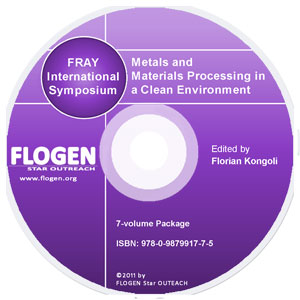
CD shopping page |
2011-Sustainable Industrial Processing Summit
|
| Editors: | Florian K |
| Publisher: | Flogen Star OUTREACH |
| Publication Year: | 2012 |
| Pages: | 708 pages |
| ISBN: | 978-0-9879917-1-3 |
| ISSN: | 2291-1227 (Metals and Materials Processing in a Clean Environment Series) |
Degradation Behavior Of Stainless Steel In PbO-CaO-SiO2 Based Slags
Annelies Malfliet1; Mieke Campforts2; Patrick Wollants3; Bart Blanpain4; SELECT * FROM contact WHERE email_address REGEXP('annelies.malfliet@mtm.kuleuven.be|mieke.campforts@eu.umicore.com|patrick.wollants@mtm.kuleuven.be|bart.blanpain@mtm.kuleuven.be')*********************1KATHOLIEKE UNIVERSITEIT LEUVEN, Heverlee, Belgium; 2UMICORE GROUP R&D, 2250 Olen, Belgium; 3KATHOLIEKE UNIVERSITEIT LEUVEN, 3001 Heverlee, Belgium; 4KULEUVEN, 3001 Heverlee, Belgium;
Type of Paper: Regular
Id Paper: 171
Topic: 5
Abstract:
Within the non-ferrous metal processing industry, stainless steel can be considered for parts that require a material with good chemical and mechanical properties at high temperature. One example is the lance inserted in the molten slag bath of an Isasmelt furnace to inject air, or oxygen-enriched air, into the slag. The use of stainless steel as lance material relies for a large part on the resistance of the material against the, often corrosive, slag. Within this framework, the interaction between PbO-CaO-SiO2 based slag and stainless steel grades with 18 to 26 wt.% Cr and 0 to 19 wt.% Ni is experimentally investigated. The PbO/SiO2 and CaO/SiO2 ratios of the slag are varied from 2.9 to 12.9 and from 0.03 to 0.2, respectively. Stainless steel samples are immersed in the slag at 1200°C during 3 hours. Thereafter they are analyzed with Scanning Electron Microscopy. In contact with pure PbO-CaO-SiO2 slag, both oxidation and liquid metal corrosion of the stainless steel through the reduction of PbO to Pb are identified as degradation phenomena. An increase in Cr content of the steel from 18 to 26 wt.% for low Ni content enables the formation and presence of a Cr2O3 layer that prevents contact between the liquid Pb and the steel. For similar Cr content but with increasing Ni content, the Cr2O3 layer loses its protective character. The steel is subject to degradation through liquid metal corrosion due to the high solubility of Ni in liquid Pb. The highest degradation rates are observed for the highest PbO/SiO2 ratio. The CaO/SiO2 ratio appears to have less influence. The addition of S to PbO-CaO-SiO2 slag influences the degradation behavior of the steel grades with low Ni content through the formation of chromium containing sulfides. This consumption of Cr decreases the tendency of the steel grade to form a protective Cr2O3 layer. Once the steel is subject to liquid metal corrosion, the sulfides form preferential penetration paths for the liquid Pb. The formation of a liquid (Ni,Pb) matte phase is considered to be responsible for the fast degradation of the steel grades with the highest Ni contents.